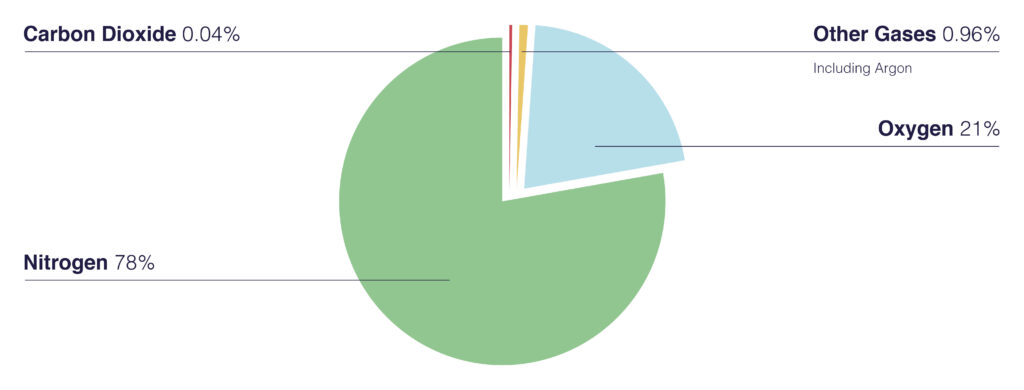One question we get asked a lot is why can’t I fit an O2 gas detector to monitor for CO2? as CO2 is an asphyxiant. This article aims to answer why you need a CO2 detector, the toxic hazards associated with CO2 and our solutions.
We will discuss the makeup of the air and how CO2 reacts with this, and the toxicological effects of CO2 on the human body to help us answer this question. CO2 is often mistakenly referred to as a simple asphyxiant which it is not. Carbon Dioxide is classed as a toxic gas under UK and US legislation.
CO2 and Normal Air
The normal level of the Oxygen in the atmosphere is 20.9% by volume. Nitrogen makes up most of the balance at 78% with 1% as Argon and a mix of other trace gases.

First alarm levels on an O2 gas detector to alert of a depletion in oxygen levels is usually set to 19.5%. The Oxygen level will be depleting either because:
- Another gas is leaking into the area causing dilution/displacement of the Oxygen level
- Something is consuming the Oxygen (Fire or Biological process)
The first depletion alarm at 19.5% represents a drop in Oxygen level of 1.4% by volume, or expressed in other units 140,000ppm (parts per million).
Most toxic gases have low ppm thresholds for exposure, for example:
- H2S first alarm 5ppm (0.0005% Vol)
- NH3 first alarm 25ppm (0.0025% Vol)
- CL2 first alarm 0.5ppm (0.00005% Vol)
Clearly the release of these gases could not be effectively monitored using an O2 gas detector. In other words, you cannot set a 5ppm alarm with an O2 gas detector monitoring to one or two decimal places.
The same is true in the case of gases such as Carbon Dioxide. CO2 is commonly present in the atmosphere, typically at around 450ppm. CO2 has occupational exposure alarms at:
- CO2 first alarm 0.5% (5000ppm) (over an 8-hour period, long term exposure limit) and second alarm 1.5% (15,000ppm) (short term exposure limit at 15 minutes)
At first glance it seems that it would be feasible to set a 0.5% depletion alarm on an O2 gas detector to monitor for CO2. However, this would be dangerous, misguided and potentially fatal.
As we have discussed 78% of the atmosphere is Nitrogen. In the event of a CO2 leak, since most of the atmosphere is nitrogen, most of the gas displaced in your application will be Nitrogen. A much smaller percentage of the Oxygen is displaced. The increase in CO2 is therefore not matched by a correlating decrease in Oxygen levels.
For example, if CO2 was present at 4% in the atmosphere, the corresponding Oxygen level would still only be 20%. Therefore, you would have exceeded both the long term and short-term exposure limits for CO2 by a factor of 8 and still not triggered an alarm.
Because CO2 is a natural part of our breathing process, it is often not considered as an asphyxiating or toxic gas. However, this can quickly become dangerous in the right conditions.
We breathe background levels of CO2 in the range of 400 to 1200ppm depending on whether you’re outdoors or in a busy office. This is processed by our lungs and is released as around 4-5% CO2 as part of the lungs metabolic function. This metabolic function works to balance the PH levels or acidity of our bloodstream, ensuring our blood is kept at a neutral level.
This process only works if there is a small amount of CO2 in the air. Areas with elevated levels of CO2 lose this balance and make it difficult for your body to disperse the excess CO2. This then causes the PH levels to become imbalanced and makes your blood more acidic (acidosis), leaving long term damage to your organs if left unchecked. Thus, classifying CO2 as a toxic gas.
The Legal Requirements of CO2 detecting
To educate users that CO2 is not an asphyxiant. A document produced by the UK Health and Safety Executive titled: Assessment of the Major Hazard Potential of Carbon Dioxide, discusses in detail the toxic effect CO2 has on the human body.
To further back this up, the UK HSE and also the American OSHA regulations have legislated exposure limits for CO2 inhalation. These being 1.5% over 15minute period (short term exposure) and 0.5% over 8-hour period (long term exposure limit). Therefore, it is dangerous to consider CO2 as a simple asphyxiant. In addition, it is required by law to have specific CO2 detectors installed and never to use Oxygen depletion monitor for this.
IGD’s Carbon Dioxide Gas Detectors
At IGD we have been manufacturing gas detection equipment for over 100 years, since our establishment in 1917. In addition, we have been manufacturing CO2 detectors even before the Second World War. Therefore, IGD have always been at the forefront of gas detection technology and actively involved in protecting human life from dangerous gases for over a century. We have multiple options for CO2 detectors from networked monitors in the form of our 750 addressable series which provide enhanced capability while reducing your overall costs. Further to this the 750 addressable series provides continuous 24/7 monitoring of the area and can activate ventilation and automatic shut of a process if a leak is detected. You can learn more about the TOC-750 series gas detectors here.
If you are transporting CO2 gas bottles, working with dry ice or in the beverage industry, then the portable iGAS CO2 detector is the ideal solution. Featuring a leading 14 day run time on a single charge, USB re-chargeable and IP68 for durability. Available to purchase online today from our online store.
Contact our team of gas detection experts today.





